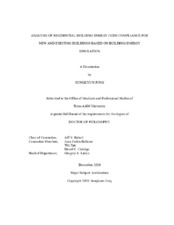| dc.description.abstract | Currently, the International Energy Conservation Code (IECC) is the most widely-used residential building energy code in the United States. Either the IECC or IECC with amendments has been adopted by 33 states. The latest version of the IECC contains three compliance requirements, including: mandatory, prescriptive, and performance paths for compliance. The performance path includes specifications for the standard house design and the proposed design to be analyzed using whole-building energy simulations. In the performance path, the annual simulated energy cost of the proposed house must be less than the annual energy cost (or source energy usage) of the standard reference house.
Unfortunately, most of the whole-building energy simulation programs are too complicated to be used by building energy code officials or homeowners without special training. To resolve this problem, simplified simulation tools have been developed that require fewer user input parameters. Such simplified software tools have had a significant impact on the increased use of the performance-based code compliance path for residential analysis. However, many of the simplified features may not represent the energy efficient features found in an existing residence. This may mis-represent the potential energy saving when/if a house owner decides to invest in a retrofit to reduce their annual energy costs.
Currently, there are building energy simulation validation methods developed by ASHRAE, and RESNET including: ASHRAE Standard-140, IEA BESTEST, HVAC BESTEST, and BESTEST-EX. These tests have been developed to test the algorithms of building energy performance simulation, which require complex inputs and outputs to view the test results. Unfortunately, even though two different building simulation validation programs may produce the necessary inputs/outputs for certification, they are rarely tested side-by-side or on actual residences. Furthermore, results from a simplified analysis of a building is rarely compared against a detailed simulation of an existing building. Therefore, there is a need to compare the results of a simplified simulation versus a detailed simulation of an existing residence to better determine which parameters best represent the existing house so more accurate code-compliant simulations can be performed on existing structures.
The purpose of this study is to develop an accurate, detailed simulation model of an existing single-family residence that is compared with a simplified building energy simulation of the same residence to help determine which on-site measurements can be made to help tune the simplified model so it better represents the existing residence. Such an improved building energy simulation can be used to better represent annual energy cost savings from retrofits to an existing building. | en |


